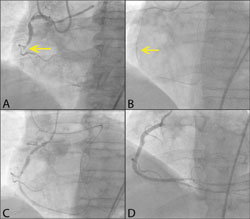The 'Magic' of Retrograde
by Emmanouil S. Brilakis, MD, PhD
Although chronic total occlusion PCI encompasses a broad and rapidly evolving spectrum of spectacular techniques, the technique that most vividly captures the imagination of interventionalists is the retrograde technique. In this technique a guidewire and microcatheter are advanced to the true lumen distal to the occlusion via a collateral vessel, facilitating CTO crossing.
|
|
Background, Reasons for Use
The retrograde approach to CTO was developed and mastered by Japanese operators during the past decade. They first discovered that small septal collaterals can be crossed by guidewires and small balloons with low risk of complications and high frequency of successful wire crossing. They realized the importance of dilating the collateral vessel to minimize the risk for equipment entrapment. The operators highlighted the importance of keeping the retrograde guidewire covered with a balloon catheter or microcatheter to minimize the risk of myocardial injury during wire manipulations. They designed techniques to enable retrograde CTO crossing, namely the controlled antegrade and retrograde tracking and dissection (CART) and the reverse CART. Finally, the operators designed dedicated equipment that has markedly facilitated performance of the procedure, such as the Corsair catheter (Asahi Intecc) designed to facilitate collateral crossing and obviate the need for balloon dilation, and the Sion and RG3 guidewires (Asahi Intecc), which are designed for collateral crossing (Sion) or externalization (RG3). The Corsair catheter and Sion wire are currently commercially available in the United States, but the RG3 wire is not.
 |
|
| Emmanouil S. Brilakis |
Retrograde CTO PCI is the “hottest” coronary interventional technique currently; it is the technique most interventionalists are interested in learning, although they are often intimidated by the potential complications. This is likely because several steps of the retrograde technique, such as wiring through collateral vessels, dilating the subintimal space in CART and reverse CART, and snaring and externalizing the retrograde guidewire, are not routinely performed in cardiac cath labs. Moreover, there is concern that complications can occur; although in several series the retrograde CTO PCI risk was low, unusual complications, such as septal hematoma, equipment entrapment, coronary perforation or donor vessel injury, can occur.
In some cases the retrograde approach may be the only feasible (or the most favorable) approach for specific CTO lesion subsets, such as ostial vessel occlusions, long occlusions, occlusions with ambiguous proximal cap and occlusions with diffusely diseased distal vessel. As a result, using the retrograde approach can increase the success rate of CTO PCI to 80% to 90% or more. Although the retrograde approach can salvage cases in which antegrade crossing fails, it is not a substitute for strong antegrade CTO PCI skills that are successful in the majority of cases.
Tips for Learning
First, retrograde CTO PCI is not an isolated technique but part of a CTO PCI program. Operators wishing to embark on this area should be prepared to spend a significant amount of time learning how to best perform these procedures, and accept that they will have several failed cases, especially during the early stages.
|
Images: Emmanouil S. Brilakis, MD, PhD; reprinted with permission. |
Second, progressive and structured training is essential. Two comprehensive, step-by-step descriptions of the procedures were published this year (Catheter Cardiovasc Interv. 2012;79:3-19 and J Am Coll Cardiol Cardiovasc Interv. 2012;5:1-11), which can provide a conceptual framework for interested interventionalists. A new website (www.ctofundamentals.org) provides extensive teaching on retrograde and other PCI-related techniques and the ability to share angiograms from interesting CTO cases with experienced CTO operators. However, the “read one, do one, teach one” philosophy does not apply to retrograde CTO PCI. Attending CTO meetings, visiting laboratories that routinely perform CTO PCI and eventually getting proctored by experienced operators are key to shortening the learning curve and minimizing the risk for complications.
Conclusion
Despite the difficulties, successful completion of first retrograde CTO PCIs is an incredibly satisfying procedure for both the operator and the patient. There is a “magic” in converting failing or undoable CTO PCI cases into successes, and the retrograde approach is responsible for a large portion of this “magic.”
References:
Brilakis ES. Catheter Cardiovasc Interv. 2012;79:3-19.
Joyal D. J Am Coll Cardiol Cardiovasc Interv. 2012;5:1-11.
Kimura M. J Am Coll Cardiol Cardiovasc Interv. 2009;2:1135-1141.
Rathore S. Circ Cardiovasc Interv. 2009;2:124-132.
Saito S. Catheter Cardiovasc Interv. 2008;71:8-19.
Surmely JF. J Invasive Cardiol. 2006;18:334-338.
Surmely JF. Catheter Cardiovasc Interv. 2007;69:826-832.
Thompson CA. J Am Coll Cardiol Cardiovasc Interv. 2009;2:834-842.
Tsuchikane E. J Am Coll Cardiol Cardiovasc Interv. 2010;3:165-171.
For more information:
Emmanouil S. Brilakis, MD, PhD, is the director of the cardiac catheterization laboratory at the VA North Texas Health Care System, Dallas, and is associate professor of medicine at the University of Texas Southwestern Medical Center, Dallas. He is also a Cardiology Today Intervention Editorial Board member.
Disclosure: Dr. Brilakis receives speaker honoraria from St. Jude Medical and Terumo; research support from Abbott Vascular; and his spouse is an employee of Medtronic.


